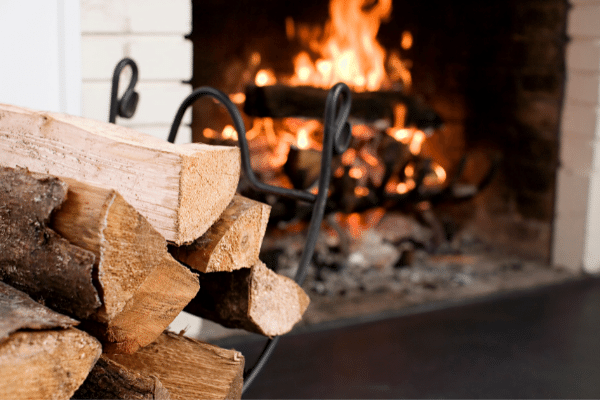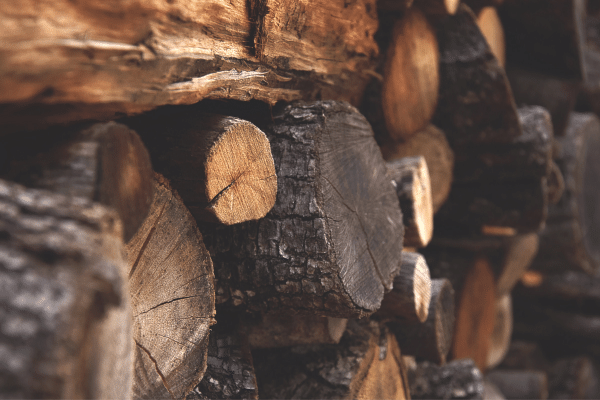- Home
- Storing Firewood
Where To Store Firewood
This post may contain affiliate links so I earn a commission.
Understanding where to store firewood so it dries fast, and stays dry until you're ready to use it, is extremely important if you want your wood to burn and not just smoke and smolder.
Let's face it, building a fire to heat your home using wood you've singlehandedly cut, split and stacked is the height of self-sufficiency.
It just makes you feel good as you watch all of your hard work be enjoyed by family and friends.
However, you'll suddenly learn that building any fire is difficult if you're using wet wood.
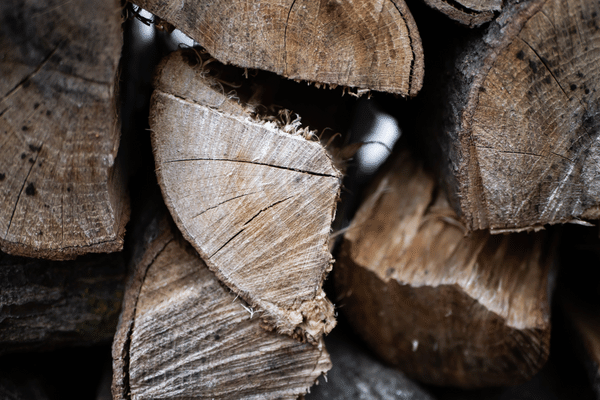
Wet firewood simply does not burn.
It will sizzle, smoke and smolder at low temperatures creating only small amounts of heat and large amounts of smoke.
These cold burning fires leave behind unburned particles that are released into the air, or even worse they'll stick to your chimney walls forming creosote.
So, no matter what type of firewood you choose to burn, the best firewood is dry firewood.
To learn more, let's look at some of the best ways to store firewood so it's dry and ready to burn when you need it the most.
Is It Better To Store Firewood Inside Or Outside?
The best place to store firewood is outside, in an area that receives a lot of sunlight and is exposed to the summer winds.
Typically for most species of trees, splitting the wood and stacking it off the ground in the early spring will help reduce the firewood moisture content to a level that's useable by late fall.
Some species are an exception to this rule, such as red oak firewood, which commonly takes at least 1-2 years to fully season.
White oak firewood is another species that takes about 1-2 years to fully season, but in my experience it dries a little faster than red oak, and it splits a little easier too.
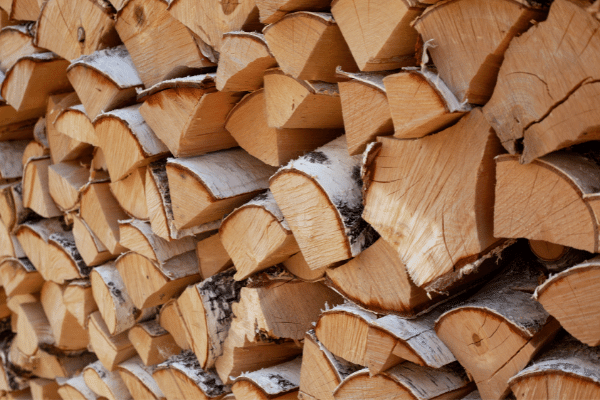
You should avoid storing wet firewood inside a garage or basement because these areas are dark, damp and do not have enough airflow to effectively dry out the wood.
Storing wet firewood inside a garage or basement will generally cause the wood to develop mold which can cause problems inside your home and for your health.
It's also recommended not to store dry firewood inside your home because you'll be faced with insects or bugs that have been living inside the dried wood.
The last thing you want to do is store firewood inside that's filled with carpenter ants or termites!
Where To Store Firewood - The Best Options
There's a variety of different firewood storage ideas that work really well.
My favorite is using a dedicated firewood shed that utilizes a pallet floor to elevate the wood, slatted sides to allow wind to penetrate the stack, and a roof to repel rain and snow.
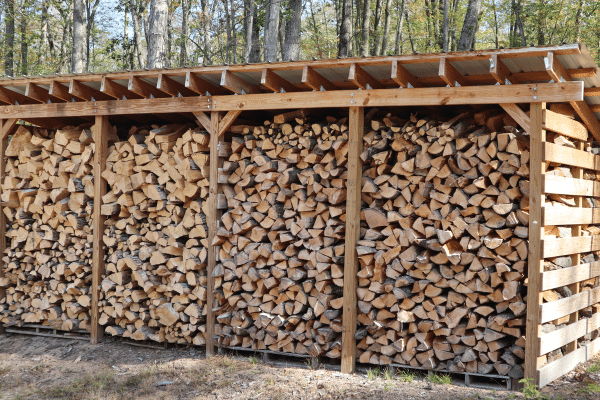
I've used this firewood shed for several years and I love it!
In fact, I even extended it a few years ago which allows me to store almost two full seasons of dry firewood, so I always have a constant rotation of dry firewood to burn.
If you don't want to build a firewood shed you still have plenty of options to store your wood so it's ready to burn.
One of that fasted ways to make a firewood rack is to use three cement blocks, a couple of 8' landscaping timbers and two 10' long 2x4's.
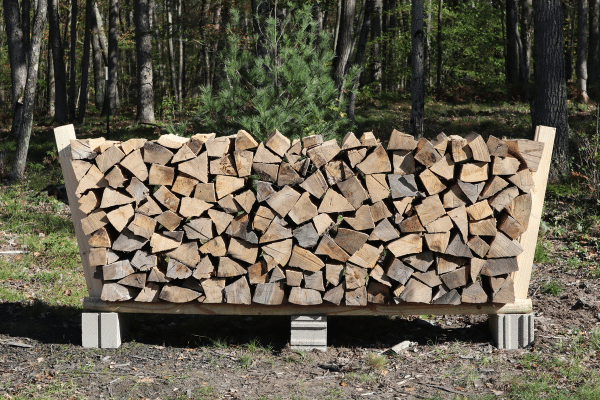
This homemade firewood rack doesn't require any tools, and you can assemble one in just a few minutes.
You can also cut the landscape timbers in half to make a DIY small firewood rack that's perfect for camping and firepits.
Just remember to use a tarp, piece of plastic, or even some old metal roofing to cover the top of the firewood stack.
It's important not to cover the entire stack, you only want to cover the top 1/3 portion.
This allows moisture to escape, while keeping rain and snow off the wood.
Also notice how this method elevates the wood off the ground?
This allows the wind to wrap all the way around the firewood stack, while also keeping bugs and insects away from the wood.
Firewood that rests directly on the ground will soak up ground moisture and begin to rot, increasing the odds of mold and unwanted insects.
What's The Best Type Of Firewood To Burn?
Understanding where to store firewood so it properly dries, and stays dry, is the secret to creating the perfect fire.
Dry firewood can make anyone look like a professional fire builder.
However, if you want to make things even easier, check out these tips that explain how to light firewood in a wood stove or fire pit to create a hot, relaxing and enjoyable fire that everyone will enjoy.
Does it really matter what type of firewood you burn?
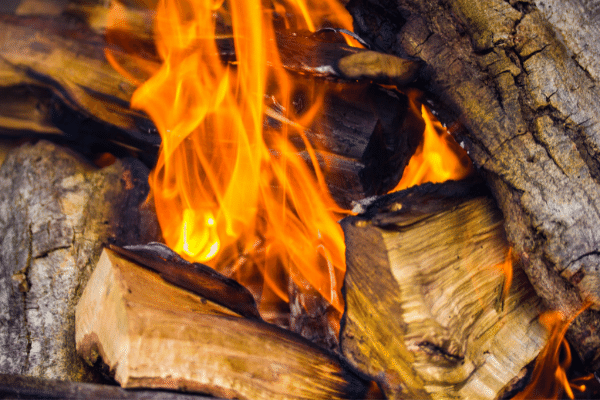
Yes, some species of wood will burn longer, hotter and create less smoke than other types of firewood.
For example, if you want a fire that creates a lot of heat with long lasting coals, hardwoods are a great choice.
Is walnut good firewood to burn?
Yes, although some types of walnut are very valuable and used for lumber (like black walnut), walnut trees that grow in urban environments usually don't produce high quality logs because they have too many limbs, resulting in poor quality lumber.
Or, if you want a campfire that burns bright, fast and is easy to light, softwoods are a good choice.
To learn more, you can check out these articles that go into additional trees in more detail:
Where To Store Firewood Near Your Home
If you're wondering where to store firewood next to your home, it's a good idea not to stack the wood directly up against your house.
Instead, choose a location that's at least 5 feet away or more from your siding or homes foundation.
This prevents unwanted insects and rodents from leaving the wood pile and entering your house.
Where To Store Firewood In Your Yard
When choosing where to store firewood in your yard, pick a location that receives plenty of sunlight.
You don't want to just throw the firewood in a pile under a group of trees because the wood won't dry.
It needs to be split, stacked off the ground and then cover the top portion of the stack to repel rain and snow.
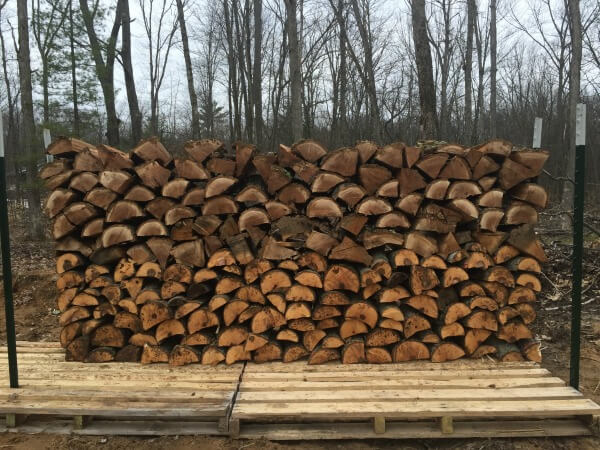
If you don't want to build or buy a firewood rack, you can use pallets with T posts on each end to serve as vertical supports.
You can generally find pallets for free online or at a local factory, and a metal T post only costs a few dollars making this type of homemade firewood rack cheap and simple to make.
Firewood Lengths And Seasoning Time
The standard firewood length is 16 inches long, split into 3-6 inch wide pieces.
This size is perfect for a majority of wood stoves, fireplaces and even for campfires.
If you split the wood too small, it will dry out faster and light easily, but it burns really fast making it difficult to have leftover coals the following morning in your wood stove.
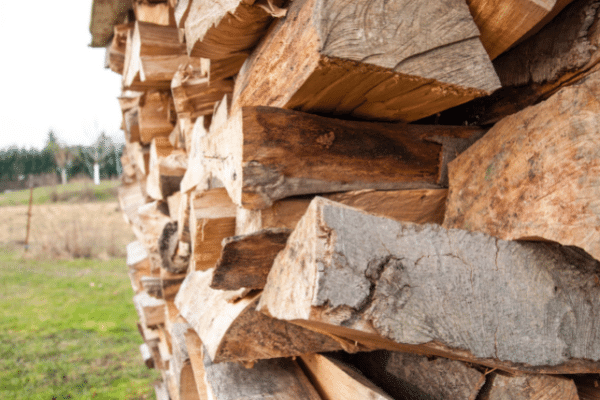
Splitting the wood too large will create a slower, longer burn but it takes a lot longer for the wood to season.
To make things easier, we've created this firewood seasoning time chart that simplifies the time various firewood species take to dry out.
Still searching for more information about the best firewood to burn?
Check out this chart that ranks firewood best to worst so you know you're always burning the best firewood possible!
Where To Store Firewood - Overall
When considering how and where to store firewood outdoors, there's a lot of different ways that work really well.
From a DIY firewood shed, to a simple cinder block firewood rack, as long as the wood is split, elevated and stacked in the sun throughout the summer, it's generally dry and ready to be burned by the time winter rolls around.
It's always best to have a one year rotation on your firewood though, meaning the wood you cut this year, should be burned next year.
By doing this, you're not rushing the seasoning process which will create perfect firewood for your next fire.
